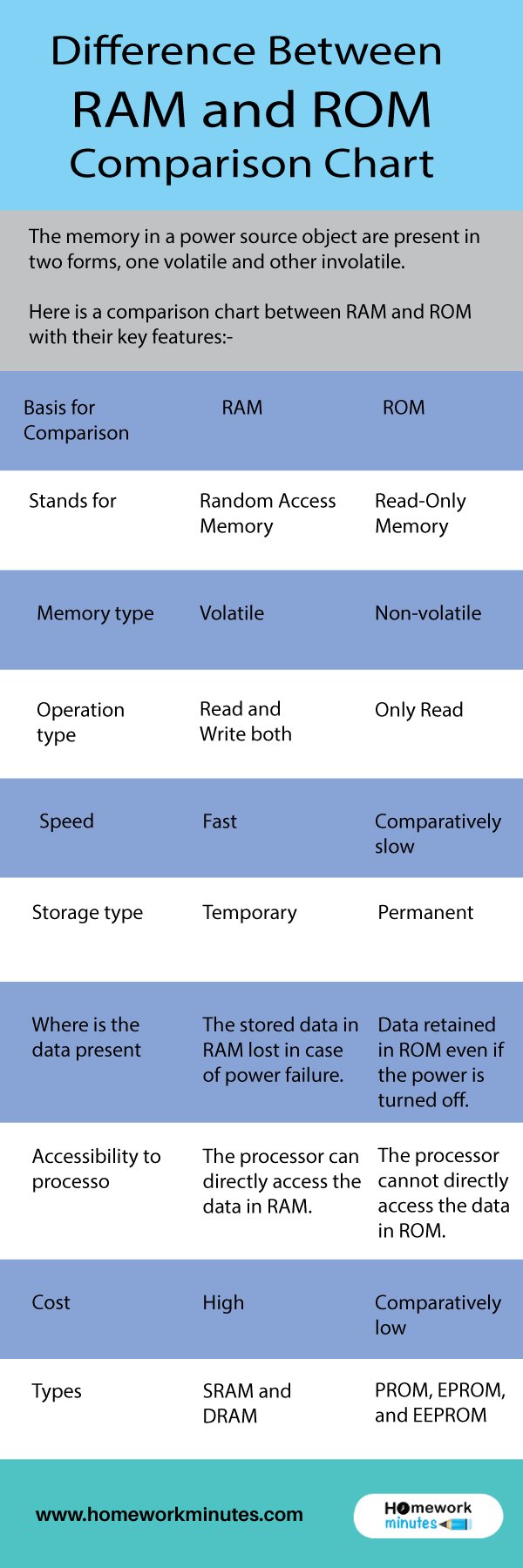Like the human body performs tasks as per the commands sent by the brain; similarly, the computer has a memory that enables to store and uses memory and data. The computer memory is of two basic types, including Random Access Memory (RAM) and Read-Only Memory (ROM). To know the differences between a RAM and ROM, you must first be interested in knowing what the two memories stand for.
To know further about the origin of computer, also read;-
Random Access Memory (RAM)
The memory in a power source object is present in two forms, one volatile and other involatile. The first form to read about is volatile memory. RAM is the primary memory of the computer that helps it in reading and writing. While the CPU executes a program, it takes the data from the RAM. By being volatile, it means that the RAM loses its data on turning off the power. RAM is further classified into SRAM (Static Random Access Memory) and DRAM (Dynamic Random Access Memory).
The differences between the two types of RAM are:-
| DRAM | SRAM |
| Formed by electricity leaking tiny-electricity capacitors | Constructed by D-flipflop circuits |
| Uses less power and generates less electricity | Uses more power and generates more electricity |
| Used for the main power | Used for the cache |
Read-Only Memory (ROM)
ROM is the in-volatile memory of the computer that information crucial to operate the system. Since the read-only memory retains its data, its main uses include usage in programming where it requires no change, in calculators and peripheral devices. The ROM is further classified into 4 main types including PROM, EPROM, EEPROM.
| PROM | EPROM | EEPROM |
| Programmable read-only memory | Erasable Programmable read-only memory | Electrically erasable programmable read-only memory |
| Programmed by the user only | Can be reprogrammed | Can be reprogrammed |
| Once programmed, the data remain unchanged | To erase data, expose to U.V. rays | To erase data, expose to the electric field |
Confused between choosing a career for your techno mind, read:-
Computer Engineering vs. Computer Science | What to Choose
Differences Between RAM and ROM
Here is a comparison chart between RAM and ROM with their key features:-
| Basis for Comparison | RAM | ROM |
| Stands for | Random Access Memory | Read-Only Memory |
| Memory type | Volatile | Non-volatile |
| Memory capacity | 1 to 256 GB per chip | 4 to 8 MB per chip |
| Operation type | Read and Write both | Only Rea |
| Speed | Fast | Comparatively slow |
| Storage type | Temporary | Permanent |
| Where is the data present | The stored data in RAM lost in case of power failure. | Data retained in ROM even if the power is turned off. |
| Accessibility to processor | The processor can directly access the data in RAM. | The processor cannot directly access the data in ROM. |
| Cost | High | Comparatively low |
| Types | SRAM and DRAM | PROM, EPROM, and EEPROM |
If you need further help in understanding any of the topics related to your programming assignment, you can get the best online assignment help from the top-experts at Homework Minutes. We’re available 24*7 to help with any topic.


